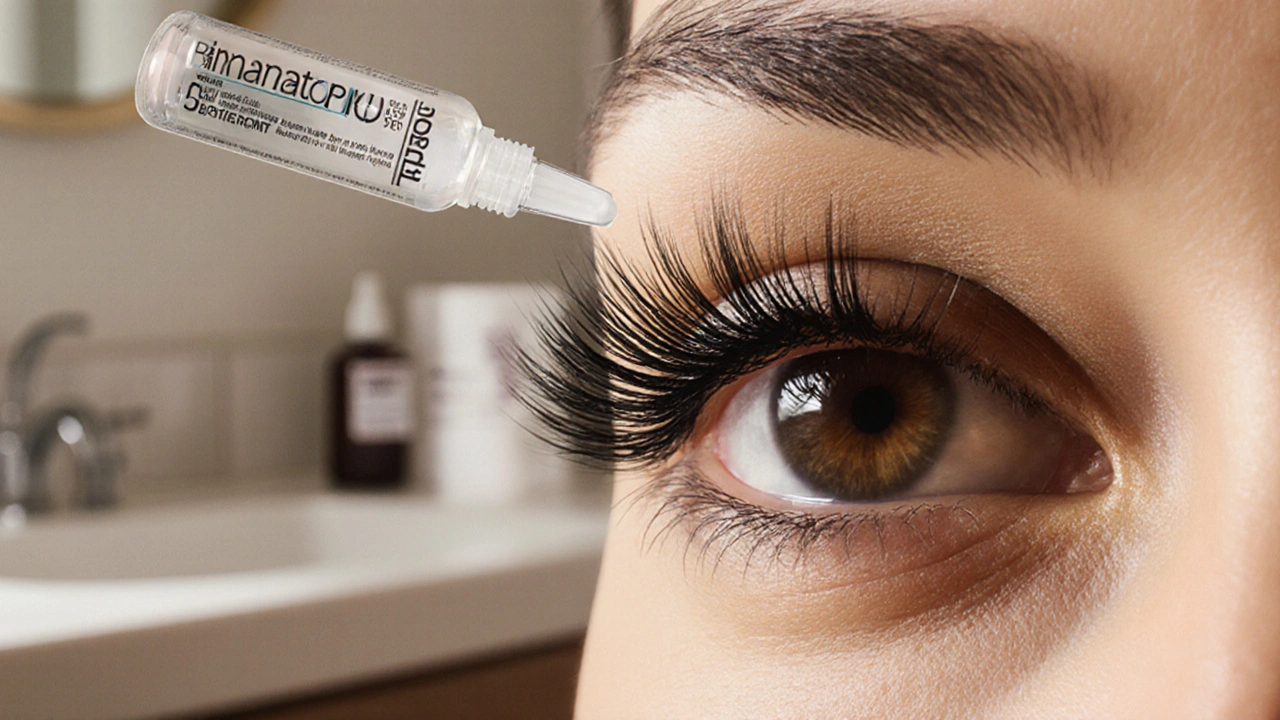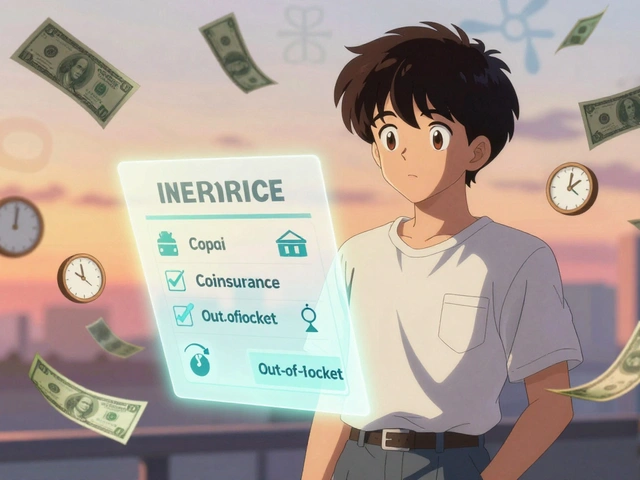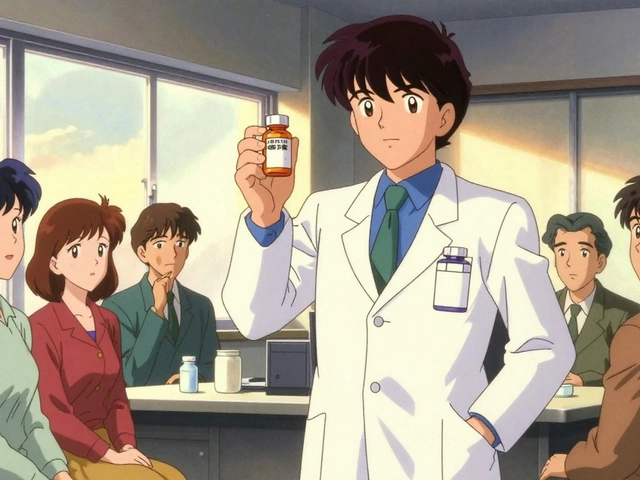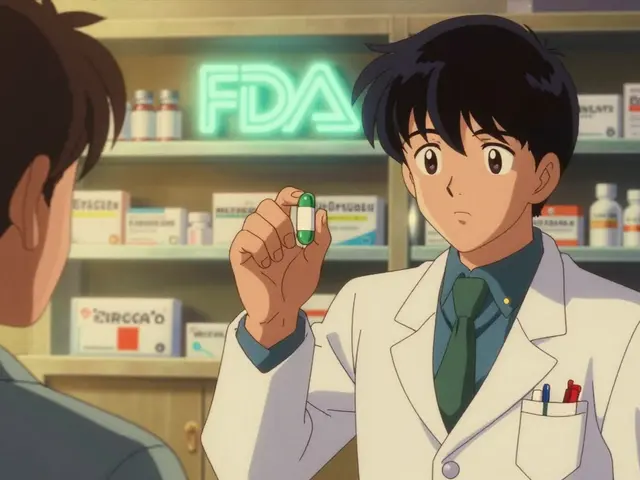Glaucoma Treatment Selector
Select your symptoms and preferences to find the best glaucoma medication for you.
TL;DR
- Bimatoprost is a prostaglandin analog effective for lowering intra‑ocular pressure (IOP) and stimulating eyelash growth.
- For glaucoma, Latanoprost, Travoprost and Tafluprost provide similar IOP‑lowering but differ in cost and side‑effect profiles.
- Timolol is a beta‑blocker that works via a different mechanism; it’s cheaper but can affect heart and lungs.
- For cosmetic eyelash enhancement, Minoxidil and off‑label Latanoprost are the main competitors, each with its own safety considerations.
- Choosing the right alternative depends on your primary goal (pressure control vs. lash length), tolerance to side effects, and budget.
When you hear the name Bimatoprost, two things usually pop up: a prescription eye drop for glaucoma and a brand‑name product (Latisse) for longer, thicker lashes. But the drug sits in a larger family of prostaglandin analogs, and there are older non‑prostaglandin eye drops that still get the job done. This article walks through the science, the numbers, and the real‑world trade‑offs so you can decide whether Bimatoprost is the right pick or if an alternative fits your needs better.
Bimatoprost is a synthetic prostaglandin analog that increases uveoscleral outflow of aqueous humor, thereby lowering intra‑ocular pressure. It was FDA‑approved for glaucoma in 2001 and later repurposed as the only FDA‑approved topical treatment for eyelash enhancement under the brand name Latisse.
How Bimatoprost Works
Prostaglandin analogs mimic the body’s own prostaglandin F2α. By binding to FP receptors in the eye’s trabecular meshwork, they remodel extracellular matrix and improve fluid drainage. The result is a 20‑30% reduction in IOP, which is enough to slow or halt optic nerve damage in most open‑angle glaucoma patients.
On the eyelash follicle, the same FP‑receptor activation prolongs the anagen (growth) phase, leading to longer, darker, and denser lashes after about 12‑16 weeks of daily use.
Key Players in the Prostaglandin Family
Below are the most common prostaglandin analogs that doctors prescribe for glaucoma. Each shares the FP‑receptor target but varies slightly in chemical structure, dosing frequency, and side‑effect profile.
- Latanoprost - marketed as Xalatan, once‑daily, slightly cheaper than Bimatoprost.
- Travoprost - sold as Travatan Z, also once‑daily, formulated with a benzalkonium‑free version for sensitive eyes.
- Tafluprost - brand name Taflotan, preservative‑free formulation, often chosen for patients with ocular surface disease.
For patients who cannot tolerate prostaglandins, older classes like beta‑blockers and carbonic anhydrase inhibitors remain viable.
- Timolol - a non‑selective beta‑blocker that reduces aqueous humor production.
- Pilocarpine - a cholinergic agonist that increases trabecular outflow via ciliary muscle contraction.
Comparing Glaucoma Treatments: Efficacy, Safety, and Cost
| Medication | Mechanism | Typical Dose | Avg. IOP Reduction | Common Side Effects | 30‑Day US Cost* |
|---|---|---|---|---|---|
| Bimatoprost | Prostaglandin F‑receptor agonist | 0.01% once nightly | 25‑30% | Eye redness, dark iris, eyelash growth | $150‑$200 |
| Latanoprost | Prostaglandin F‑receptor agonist | 0.005% once nightly | 22‑28% | Redness, iris darkening (rare) | $90‑$130 |
| Travoprost | Prostaglandin F‑receptor agonist | 0.004% once nightly | 23‑29% | Conjunctival hyperemia, eyelash growth | $110‑$150 |
| Tafluprost | Prostaglandin F‑receptor agonist | 0.0015% once nightly | 20‑26% | Dry eye, mild redness | $130‑$180 |
| Timolol | Beta‑blocker (reduces production) | 0.5% twice daily | 15‑20% | Bradycardia, bronchospasm, fatigue | $30‑$60 |
*Prices based on average retail pricing in 2025, not accounting for insurance coverage.
From a pure efficacy standpoint, Bimatoprost sits at the top of the prostaglandin line‑up, delivering the deepest IOP drop. The trade‑off is a higher price tag and a higher chance of iris pigmentation change. If cost is the main driver, Latanoprost usually wins. For patients with dry eye or allergic conjunctivitis, preservative‑free Tafluprost can be kinder to the ocular surface.

Beyond Glaucoma: Eyelash‑Growth Alternatives
When the goal is cosmetic, the competition shifts. Bimatoprost (as Latisse) is the only FDA‑approved eyelash enhancer, but doctors and DIY enthusiasts have tried a few other routes.
- Minoxidil - originally a hair‑growth topical for scalp, 2% or 5% solution applied to the lash line. It works by opening potassium channels, lengthening the anagen phase. Clinical data show about 10‑15% increase in lash length, but irritation is common.
- Off‑label Latanoprost - some dermatologists prescribe the glaucoma drop for lashes, achieving results similar to Bimatoprost but with a slightly milder side‑effect profile.
- Natural oils (castor, rosemary) - anecdotal evidence only; no controlled trials support measurable growth.
Side‑Effect Cheat Sheet
Understanding the safety landscape helps you weigh “good enough” versus “best possible.” Below is a quick reference for the most frequent concerns.
| Medication | Ocular | Systemic | Special Warnings |
|---|---|---|---|
| Bimatoprost | Redness, hyperemia, darkening of iris, peri‑ocular skin pigmentation | None reported at therapeutic dose | Avoid in pregnant women; monitor for unwanted iris color change. |
| Latanoprost | Redness, foreign‑body sensation, mild eyelash growth | None | Rare iris darkening; caution in patients with uveitis. |
| Travoprost | Conjunctival hyperemia, eye pain | None | Benzalkonium‑free version reduces allergy risk. |
| Timolol | Transient stinging | Bradycardia, bronchospasm, depression | Contraindicated in asthma or severe COPD. |
| Minoxidil | Eye irritation, dryness | Rare systemic hypotension | Do not use near nasal passages; keep away from children. |
Choosing the Right Option: Decision Tree
- Is your primary concern lowering IOP?
- Yes → Start with a prostaglandin analog (Bimatoprost > Latanoprost > Travoprost > Tafluprost) based on cost and tolerance.
- No → Consider beta‑blocker (Timolol) if you need a cheaper alternative and have no cardiac/lung issues.
- Do you also want longer lashes?
- Yes → Bimatoprost (Latisse) is the only FDA‑cleared choice. Off‑label Latanoprost works but requires a compounding pharmacy.
- Prefer over‑the‑counter? → Try 2‑5% Minoxidil with caution.
- Any history of eye allergies or dry eye?
- Yes → Preserve‑free Tafluprost or Travoprost without benzalkonium chloride.
By walking through these simple questions, you can land on the medication that hits the sweet spot between effectiveness, safety, and budget.
Practical Tips for Getting the Most Out of Your Drops
- Apply drops at the same time each day-most prostaglandins work best when taken at night.
- Pull down the lower eyelid gently and place one drop into the cul‑de‑sac; close eyelid for 2 minutes to aid absorption.
- Never share bottles; contamination can cause infections.
- Schedule a follow‑up eye‑pressure check 4‑6 weeks after starting or switching medications.
- If you notice darkening of the iris, discuss alternatives with your ophthalmologist; the change can be permanent.
Frequently Asked Questions
What conditions is Bimatoprost approved to treat?
In the United States, Bimatoprost is FDA‑approved for two indications: (1) reduction of intra‑ocular pressure in open‑angle glaucoma or ocular hypertension, and (2) treatment of inadequate eyelashes, marketed as Latisse.
How does Bimatoprost compare to Latanoprost for glaucoma control?
Clinical trials show Bimatoprost typically lowers IOP by an additional 2‑3% compared with Latanoprost. The difference is modest, but it can be decisive for patients whose pressure hovers near the treatment target.
Can I use Bimatoprost if I have asthma?
Bimatoprost itself has no known systemic respiratory effects, unlike beta‑blockers such as Timolol. However, always confirm with your eye‑care provider, especially if you need combination therapy.
Is Minoxidil a safe alternative for longer lashes?
Minoxidil can stimulate lash growth, but it is not FDA‑approved for that use. Users report eye irritation and occasional contact dermatitis. If you choose Minoxidil, start with a low‑concentration (2%) and monitor closely.
What should I do if my iris darkens while using Bimatoprost?
Iris color change is usually permanent. If the cosmetic change bothers you, discuss switching to a prostaglandin with a lower pigmentation risk (like Latanoprost) or a non‑prostaglandin agent. Keep a baseline photo of your eyes for future reference.
Whether you’re battling high pressure, hoping for fluttery lashes, or both, the right medication hinges on a balance of effectiveness, side‑effect tolerance, and cost. Bimatoprost offers top‑tier IOP control and the only FDA‑cleared lash boost, but alternatives like Latanoprost, Travoprost, Tafluprost, and Timolol give you flexibility when price or ocular comfort matters. Armed with the data above, you can have a focused conversation with your eye doctor and land on the option that feels right for you.







Holly Hayes
September 30, 2025 AT 12:46bimatoprost is overrated its only for rich folks who dont care about side effects
Penn Shade
October 6, 2025 AT 15:26If you’re comparing prostaglandin analogs, start with the efficacy numbers.
Bimatoprost consistently achieves a 25‑30 % IOP reduction, slightly ahead of latanoprost’s 22‑28 %.
Cost is the next variable: generic latanoprost hovers around $100 for a month, while bimatoprost can exceed $150.
Side‑effect profiles also differ-iris darkening is more common with bimatoprost.
The decision matrix ultimately balances pressure control, budget, and tolerance.
Jennifer Banash
October 12, 2025 AT 18:06The pharmacological superiority of bimatoprost within the prostaglandin class warrants meticulous consideration.
Clinical trials have demonstrated that its mean intra‑ocular pressure reduction exceeds that of its peers by approximately two to three percent.
Such a margin, albeit modest, can be decisive in patients whose target pressure hovers near the therapeutic threshold.
Moreover, bimatoprost possesses the unique distinction of being the sole FDA‑approved agent for cosmetic eyelash enhancement.
This dual functionality, however, is accompanied by a heightened propensity for pigmentary alterations of the iris.
Patients must be counseled that once melanogenesis occurs, reversal is unlikely.
From an economic perspective, the medication commands a premium price, often surpassing $180 for a thirty‑day supply.
Insurance formularies may restrict access, compelling clinicians to evaluate generic latanoprost as a cost‑effective alternative.
Nevertheless, for individuals prioritizing maximal pressure control, the incremental efficacy justifies the expense.
It is also pertinent to note that adherence is optimized when dosing occurs at night, aligning with the drug’s pharmacokinetics.
Adverse ocular events such as conjunctival hyperemia and peri‑ocular skin darkening occur more frequently with bimatoprost than with latanoprost.
Patients with a history of ocular surface disease may experience exacerbation of dry‑eye symptoms.
In such scenarios, preservative‑free formulations of tafluprost present a viable compromise.
While beta‑blockers like timolol remain financially attractive, their systemic side‑effects preclude use in asthmatic or bradycardic individuals.
Consequently, the therapeutic algorithm must integrate efficacy, safety, tolerability, and fiscal considerations.
In summary, bimatoprost stands as a potent agent whose selection should be individualized based on patient‑specific risk–benefit appraisal.
Jennifer Pavlik
October 18, 2025 AT 20:46When you’re picking a drop, think about what matters most to you-pressure control, cost, or lash length.
If budget is tight, latanoprost usually does the job for less money.
If you really want longer lashes, bimatoprost (Latisse) is the only FDA‑cleared option.
Talk to your eye doctor about any dryness; there are preservative‑free choices.
Jacob Miller
October 24, 2025 AT 23:26Even though the efficacy data looks solid, you’re ignoring the long‑term cosmetic impact on iris color.
Patients often forget that pigment changes can be permanent and affect their appearance.
carlee Lee
October 31, 2025 AT 01:06That’s a good point, I appreciate the added nuance.
Gareth Pugh
November 6, 2025 AT 03:46Picture this: a night‑time drop that not only saves sight but also adds drama to your lashes – that’s the bimatoprost promise, wrapped in a bottle of ambition.
anshu vijaywergiya
November 12, 2025 AT 06:26Let us not forget the human side of this discussion – every patient’s journey is a tapestry of hopes, fears, and the desire for a brighter gaze.
ADam Hargrave
November 18, 2025 AT 09:06Oh great, another “miracle” drop that will solve everything 🙄. Sure, if you’ve got a wallet the size of a small country, go ahead.
Michael Daun
November 24, 2025 AT 11:46i think bimatoprost works well but if cost is an issue latanoprost is still a good opton
Rohit Poroli
November 30, 2025 AT 14:26From a clinical‑pharmacology standpoint, the trade‑off between maximal IOP lowering and pigmentary side‑effects can be framed as a risk‑benefit ratio, and the decision algorithm should incorporate patient‑specific comorbidities.
William Goodwin
December 6, 2025 AT 17:06💡✨ Everyone loves a good win‑win: lower pressure and longer lashes! Just remember to keep the drop schedule consistent – night time is key. 🌙👁️🗨️
Isha Bansal
December 12, 2025 AT 19:46While the preceding exposition admirably enumerates the pharmacodynamic virtues of bimatoprost, it regrettably neglects to address the linguistic precision required in patient education.
The omission of clear, unambiguous terminology regarding potential iris pigmentation can foster misinterpretation.
Furthermore, the author’s occasional reliance on colloquial abbreviations such as “IOP” without prior definition may perplex lay readers.
In a discipline where exactitude is paramount, syntactic rigor must accompany clinical accuracy.
Thus, I recommend a revision that integrates both scientific exactness and grammatical fidelity.
Ken Elelegwu
December 18, 2025 AT 22:26One must contemplate the epistemological ramifications of choosing a medication that simultaneously serves therapeutic and aesthetic ends; the very act of merging function with vanity challenges traditional medical hierarchies.
Gene Nilsson
December 25, 2025 AT 01:06It is incumbent upon us to uphold the sanctity of ocular health, and to that end, bimatoprost, despite its high cost, should be reserved for those who can truly benefit from its superior efficacy.